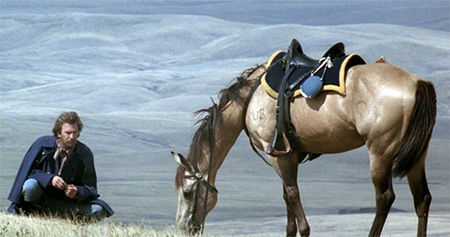
The 1990s opened by showcasing a horse-human relationship in a film that went on to win the 1991 Best Picture Oscar Award. When “Dances with Wolves” filled movie theaters (remember those?) hearts thumped loudly. But for horse lovers everywhere the question remains, did hearts thump louder for John Dunbar or the dun horse ‘Cisco’?
It was clearly a dynamic, productive and energizing time for the Boulder County Horse Association, and horse folks throughout Boulder County. The BCHA archives for the 1990s provided me with huge stacks of material. In the BCHA Horse Services Directory from that era it lists:
- a bale of brome grass/alfalfa mix hay for $4.00
- a annual BCHA individual membership for $5.00
- horse boarding near Rabbit Mountain for $40/month ($50 in winter including hay)!
In the early 90s, Randy Winter was at the helm as President of BCHA. He was followed by Creighton Stewart. After his stint as president, Randy continued to write articles with a philosophical bent for the BCHA newsletter. He cleverly titled his column Centered Writing, a nod to famed New England horsewoman of the time, Sally Swift. For example, in February 1990 Randy wrote: Why did the chicken cross the road? To get to the other side. There must have been something over there it wanted. Why does my horse, Gus, move on down the road? Usually it’s because he wants to get home quicker. Why do a group of dedicated people continue to travel the road? It’s to get to meetings….to discuss the future of a bunch of horses and their owners….”
By the mid-90s BCHA leadership included Tracy Speich, Eloise Joder (Joder Arabian Ranch), Rhonda Goddard and Suzanne Webel. The decade closed with Suzanne Webel as President, and Mardi Devolite as Vice President. The cover article for the final newsletter of the decade reads, Horse Ownership in Boulder County in Significant Decline.
Education. Legislation. Recreation.
In 1971, BCHA formed its Board of Directors and announced their goals: Education. Legislation. Recreation. Throughout the 1980s those goals were clarified and reiterated many times. In 1998 the organization went through a lengthy soul-searching process under the guidance of a trained facilitator. Those same goals emerged once again. The energy surrounding Education. Legislation. Recreation, throughout the 1990s is evident throughout newsletter articles, newspaper clippings, photographs and conversations with BCHA leaders of that time.
Education
The depth and breadth of BCHA’s educational focus seemed to expand vastly during the 1990s. Meaty articles on animal health, area history, trails and legislative updates graced the covers of monthly newsletters. Guest authors included Dr. Nancy Loving, DVM, and the late local historian and horsewoman Joanna Sampson.
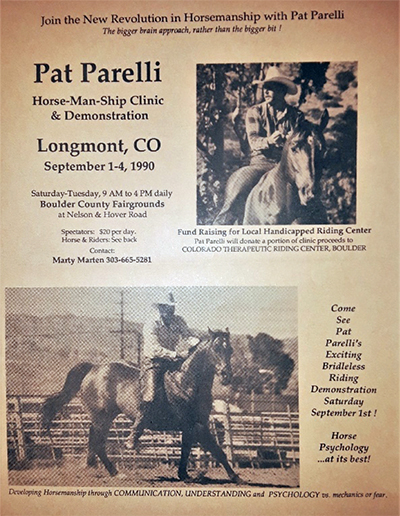
Natural Horsemanship
Regular local educational clinics and seminars throughout the 1990s were offered by the likes of Pat Parelli (right), the late Marty Marten ,and Buck Branaman. Perhaps it’s not surprising that in the 90s Boulder County was a fertile environment for the budding natural horsemanship movement to take off.
Mounted Search and Rescue
Cathy Bryarly joined the BCHA Board of Directors in 1990, and by the mid-90s she had become a Boulder County Sheriff’s Office deputy. I had the pleasure of speaking with Cathy over the phone recently. She cites two specific reasons for becoming involved with BCHA:
- The first came from her desire to help the sheriff’s office, in conjunction with animal control, to develop a database of horses and horse-owners to assist with reunifications. Whether it was a broken fence or an emergency evacuation, Cathy saw an alarming number of loose horses in Boulder County. She felt it was important to create a horse-community driven tool rather than a ‘Big Brother’ approach that came from the top down. Out of this interest grew the Horse Owner’s Operation Find (H.O.O.F) project. Today in Boulder County, and in light of this years fires, H.O.O.F is still a vital and important tool for the Boulder County Sheriff’s Office (BCSO) to reunite horses and livestock with their owners.
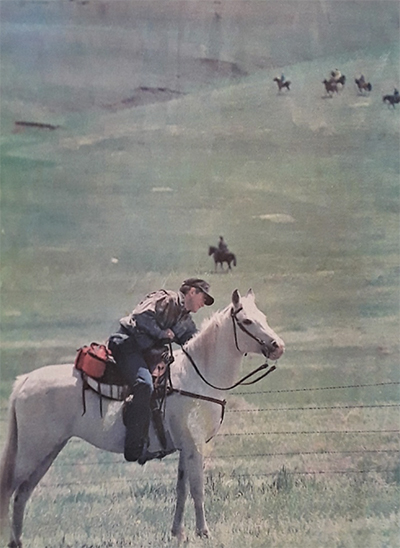
Boulder Daily Camera (date not available). Heidi Grimditch searches for clues with her squad, which is based in south Boulder. - The second thing that drew Cathy to BCHA was wanting to make sure people would have trails to ride. She says, it was a big issue in the 90s, and now 30 years later it’s still one of the main issues facing horse people in Boulder County.” Cathy states, “BCHA made a huge effort and that’s one of its big successes, making sure Boulder County stays open to horses.” She feels strongly that “Working together to try to figure out how to make stuff work, works better than contentiousness. It doesn’t do any good to complain…”
Cathy reports there is still an active mounted patrol, but their role and presence are very limited due to time constraints on staff. She retired this year in March and has gone back to work as a seasonal ranger for Boulder County. She’s hoping to “get going again with mounted patrol.”
Numerous articles published in the Daily Camera during the late 90s showcase the hard work and effort of mounted search and rescue training. By 1998 a BCHA mounted search and rescue unit was formed in conjunction with Boulder County Sheriff’s Department.
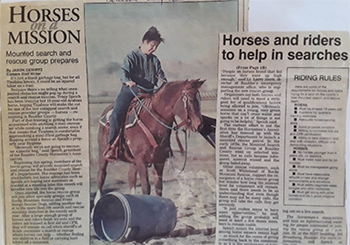

Legislation
Open Space Advisory Committee (POSAC)
In 1990 BCHA’s Vice President, Creighton Stewart was also a member of Boulder County’s Parks and Open Space Advisory Committee. In this capacity he reported back to BCHA members through his newsletter column. As he put it, “Open space, or the absence of intense development, compliments equestrian interests….The objective of Boulder County’s Open Space program, of course, is not to preserve horse-keeping, you and I are going to do that by vigilance…to do that, it is important that horse owners remain aware of the workings of some aspects of government such as the Open Space program of Boulder County.”
The Equine Liability Act & Agriculture Tax Status
Other key legislative work of the 90s decade included passage of Senate Bill 90-84, signed into law by Governor Romer on July 1, 1990. This is the Equine Liability Act and we have our BCHA forbears to thank for tireless letter-writing and phone calls to Colorado State Legislators to pass this bill keeping our liability exposure and costs lower than they would otherwise be. Prior to passage of this bill in 1990 it’s noted that Colorado had among the highest equine liability insurance costs of any state.
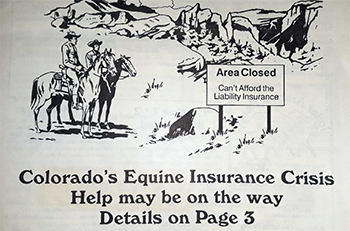 The agricultural tax status was also becoming problematic in the 90s. Horse facilities in Boulder County were getting squeezed by changes in zoning language which could have changed the face of small horse-keeping properties in the county if not for dedicated hard work of people like Jody Murray who wrote in August 1990:
The agricultural tax status was also becoming problematic in the 90s. Horse facilities in Boulder County were getting squeezed by changes in zoning language which could have changed the face of small horse-keeping properties in the county if not for dedicated hard work of people like Jody Murray who wrote in August 1990:
For the last two years, I have been doing battle with the Boulder County Assessor’s Office over their changing our classification from agricultural to rural residential, although nothing had changed regarding our property use or with the State Statute. The problem was with the County and State Assessor’s Offices, taking upon themselves to change their interpretation of the Statute covering horses and horse properties.
Thanks to efforts by Jody and people like her, some wording in Bill 1018 was changed before it was passed into law in 1990 which protected the definition of ‘agriculture’ to include grazing of livestock/domestic animals used for breeding, work and profit in addition to consumption. Jody Murray wrapped up her article by imploring: ‘Election time is coming and we need people who are sympathetic toward agriculture and horse activities and the state and county levels of government.’ Amen!
Equestrian Center Defined
- By the latter part of the decade, after concerted effort and hours of dedicated work BCHA in conjunction with Boulder County achieved an important compromise by clarifying a legally binding definition of ‘Equestrian Center’, thereby protecting small, backyard horse keeping from onerous rules and regulations.
- In August 1999 a newsletter article discusses the contentious public hearing for the Colorado Horse Rescue’s (CHR) proposed move to its current location on North 65th Street in Longmont. It’s reported there were 100 speakers during the four-and-a-half-hour long meeting, with about half the speakers for and half against CHR’s move to the Longmont area. …Neighbors…just flat out did not want CHR in their backyards. They had convinced themselves that CHR volunteers would bring crime to their neighborhood and ruin the peace and quiet they so enjoy. Neighborhood organizers had whipped them into a lynch mob… BCHA supports CHR’s move to the county as we feel that the organization has proven itself to be of great value to the horse community at large…It is our hope that BCHA members will be among the first to volunteer to help give abandoned and unwanted horses a future in Boulder County.
- By the late 1990s BCHA earned its non-profit status with the IRS as a 501(c)(3), facilitating tax-deductible contributions.
Recreation
With Randy Winter in the saddle in the early 90s BCHA transitioned from leading monthly trail rides to featuring ‘Trail Happening’ write-ups in each newsletter. Doudy Draw, White Ranch Park, Golden Gate State Park and Homestead Meadows were among the early featured rides.
- The Five Year Trail Plan was adopted in 1990. Through this plan the Boulder Trails Committee, Open Space Board, and Parks & Recreation Advisory Board along with participation by BCHA members, outlined four ‘new’ trails to fulfill existing bike and pedestrian needs within Boulder Valley. You can see and experience the evolution of this early work all around you in your forays throughout Boulder Valley today.
- By 1998 “Happy Trails” volume 1 and 2 were completed by BCHA. These provided local equestrians detailed trail guides and trail information. Much of this can now be found on the “Trails” page of the BCHA website, and past blog posts.
Community outreach and recreational efforts continued throughout the decade. Civic engagement saw BCHA leaders and members out cleaning up sections of adopted highways and volunteering for annual maintenance of Doudy Draw Trail. The Horse Lover’s Fling & Silent Auction brought in important funds and supported networking and community-building. And by 1998 the second annual BCHA Fun Show at the Boulder County Fairgrounds took place with whopping 80 participants!
Equestrian access to area trails continued to be a constant theme throughout the 90s, but concerns appear amplified toward the latter part of the decade. In a letter published in the Daily Camera in 1998, Eloise Witt Joder of Joder Arabian Ranch asks the prescient question: “Why must the trail advocates and the environmentalists keep fighting each other in the press, meetings and hearings when we should be allies?”
End of the 90s
The August 1999 newsletter names 13 individuals on the BCHA Board of Directors. It lists seven distinct committees including Trails, Mounted Search and Rescue, and Events and Education. Those committees are headed by no less than 29 BCHA members. So while horse ownership in the county may have been in decline, engagement in BCHA was way up from where we find it today.
As the decade wrapped up, then-president Suzanne Webel found herself going through the boxes of archived material she had herself ‘inherited’ from her BCHA predecessor. She had this to say about the BCHA archives and history: …What emerged from my review of the BCHA archive was the profound and ongoing dedication of your organization’s leaders, in the face of increasing pressures to obliterate a cherished lifestyle that most of us have sought here. There have been some stunning successes, some sad failures, and some great ideas that just faded away into the sunset. But the idealism lives on, for those who seek it.
Clare Tone is a BCHA Board member and freelance writer living in western Boulder County. In this monthly column leading up to the 50th anniversary she will explore the rich history of BCHA.
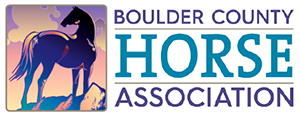

 Do you have stories or photos from BCHA’s past?
Do you have stories or photos from BCHA’s past?